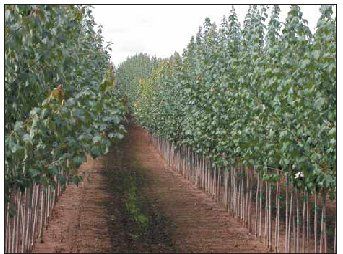
Publisher:
Bonnie King
CONTACT:
Newsroom@Salem-news.com
Advertising:
Adsales@Salem-news.com

~Truth~
~Justice~
~Peace~
TJP
Feb-07-2008 08:52

 TweetFollow @OregonNews
TweetFollow @OregonNews
Research Grants Help Address Nursery Industry Problems
Salem-News.comAwards for 2008 have recently been announced.
 Photo courtesy: OSU Extension Service |
(SALEM, Ore.) - Oregon's nursery industry is approaching a billion dollars in production value, making it easily the state's top agricultural commodity. But nursery growers are not without challenges, ranging from pests and diseases to reducing input costs.
That's why the industry values research to the point of literally taxing itself so that scientists can help. Part of the fees collected by the Oregon Department of Agriculture for nursery licenses goes to support a nursery research grant program that annually awards funds to worthy projects. Awards for 2008 have recently been announced.
"Research is such an important part of keeping Oregon's nursery industry at the top," says Mt. Angel grower Tom Fessler, a member of the State Board of Agriculture and a past president of the Oregon Association of Nurseries (OAN).
"In order to maintain and enhance the quality of our product, we need better ways to deal with production problems, whether they are pests, diseases, conservation challenges, or the way we grow our plants. This research program and the money it provides helps."
Out of 22 funding requests this year, 12 projects have received grants from the nursery research program totaling $185,000. Some of the money is allocated to continuing projects while others are new.
In some cases, OAN and the industry supplement the research grants so proposals are funded as fully as possible. Oregon is one of the few states where the industry as a whole is willing to put aside money for research. Growers realize that independent funding is key to keeping Oregon a leading nursery state.
Only projects that benefit a large portion of the industry and not just a handful of growers are awarded grants from the research fund.
"A lot of the projects deal with pest and disease problems, but many also deal with cultural issues– how the plants are grown, fertilizer needs, and those types of important factors," says Gary McAninch, supervisor of ODA's Nursery and Christmas Tree Program.
One of the biggest threats to Oregon's nursery industry the past few years has been Phytophthora ramorum– the fungus that causes sudden oak death. P. ramorum causes leaf blight, dieback, or death in certain trees and shrubs including tanoak, rhododendron, viburnum, and camellia. Susceptible plants include species important to Oregon’s native forests, horticultural landscapes, and the nursery industry.
A vigorous inspection and certification program has been in place for Oregon nurseries the past few years to detect and eradicate any outbreaks of P. ramorum. In addition, state and federal officials continue to battle the disease in Curry County on the southern coast– the only site where sudden oak death has been found in Oregon's natural environment.
"As far as disease research goes, Phytophthora ramorum is still very important," says McAninch.
Researchers from Oregon State University and the U.S. Department of Agriculture's Agricultural Research Service (ARS) continue working on effective strategies to deal with P. ramorum. Dr. Jennifer Parke at OSU has received $30,000 in this year's funding cycle for phase two of a study of overhead irrigation to minimize Phytophthora diseases. Niklaus Grunwald of ARS has received $22,000 to specifically study the epidemiology of Phytophthora pathogens on rhododendron.
Two other projects dealing with plant pests are being funded. OSU associate professor Robin Rosetta is receiving a total of $14,362– with some of the money coming from a separate industry fund– to investigate the seasonal biology and economic impact of eriophyid mites in Oregon nurseries. These tiny parasites can deform the leaves on plants. OSU researcher Melodie Putnam has received $13,801 to assess treatments for prevention of two plant deformities– crown gall and leafy gall– in herbaceous perennials.
The list of grants includes several that focus on improving production of nursery plants and some that can be considered conservation-oriented:
Jim Owen, Jr. of OSU to quantify winter discharge of controlled release fertilizers to determine environmental impact and plant uptake, ($17,235) and to study the effect of container architecture on growth and water use efficiency of rooted trees. ($5,700)
Harold Pellett of the Landscape Plant Development Center (a non-profit research institute based in Minnesota) for development of new, superior cultivars of landscape plants. ($10,000)
Barabara Reed of ARS to study improved mineral nutrition for micropropagation of woody nursery crops. ($19,800)
Erin Shroll of OSU for work on establishing various plants as part of an ecoroof– a vegetated roof system used in place of a conventional roof. ($15,000)
Guihong Bi of Mississippi State University to study nitrogen use efficiency and plant growth of container nursery plants through autumn foliar urea applications. ($13,801)
Les Fuchigami of OSU to produce a handheld meter and database system for determining chlorophyll, nitrogen, and water content of nursery plants. ($21,160)
Carolyn Scagel of ARS to study the influence of nitrogen fertilizer application rates on how well rhododendron cultivars handle cold weather. ($12,125)
ODA officials believe this type of funding is money well spent, especially since its nursery inspectors need to certify a clean and healthy product before it can be shipped.
"If the industry can produce a cleaner, more pest and disease-free product, then it makes our job that much easier," says McAninch. "The health of the industry depends on producing high quality stock. This research is a very important step in the process of assuring high quality Oregon nursery products."
Salem-News.com:





Terms of Service | Privacy Policy
All comments and messages are approved by people and self promotional links or unacceptable comments are denied.
[Return to Top]
©2025 Salem-News.com. All opinions expressed in this article are those of the author and do not necessarily reflect those of Salem-News.com.